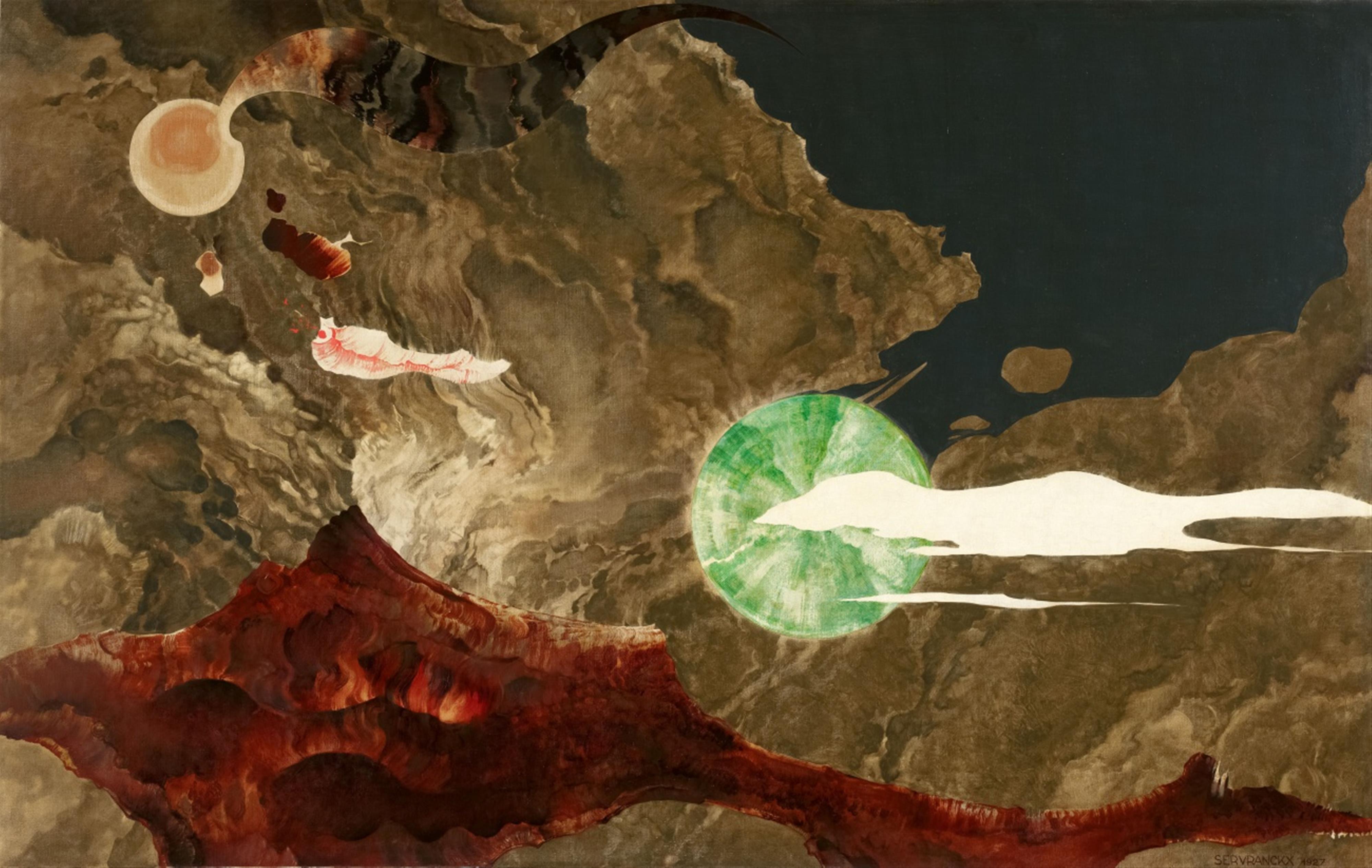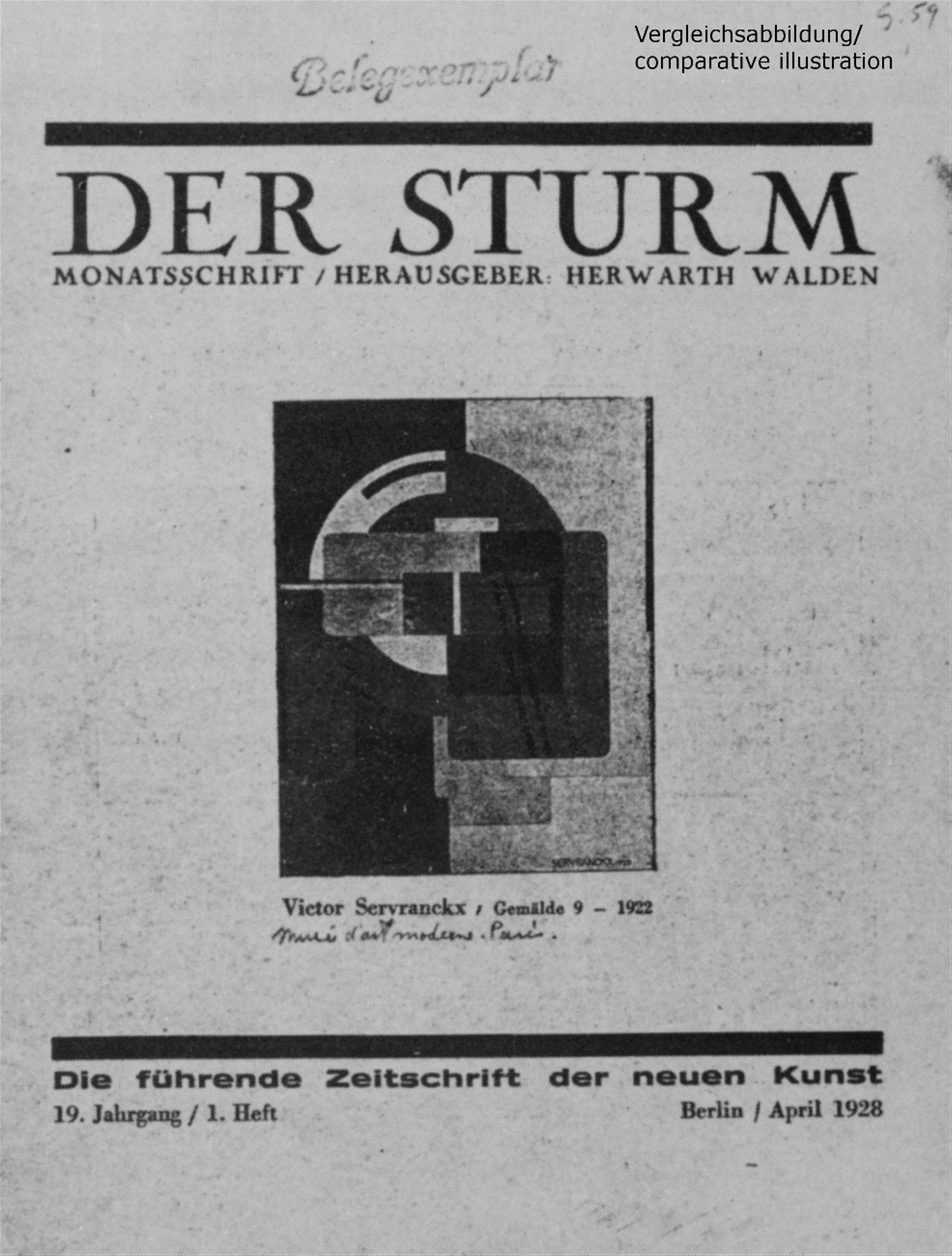Victor Servranckx
opus 9 - 1927
1927
Oil on canvas 130/130.6 x 205.7 cm Framed. Signed and dated in dark brown lower right 'SERVRANCKX 1927'. - In the area of the canvas margins at places with small retouches, due to traces of former framing. - The canvas margins relined. - In fine condition. - Verso with exhibition labels.
The work of Victor Servranckx was first exhibited at the Galerie Giroux in Brussels in 1917 and this was followed by a 1918 stay in Paris at “L'Effort Moderne”, where he met Marinetti, Theo van Doesburg, Fernand Léger and Marcel Duchamp. While he is seen as the essential legendary pioneer of abstract art in Belgium - specifically in a Constructivist vein - even then it had already become clear after a few years that the artist was always drawing comparisons between the world, art and life and measuring them theoretically as well as practically against his own individual standards. He was committed and convinced in tracking the pulse of the time contrary to all established orthodoxy. With his exceptional sensitivity the artist reacted particularly strongly to the ideas and work of his companions, who were also his friends, but he nevertheless scarcely permitted himself to be one-sidedly appropriated.
The isms that blossomed at a frenetic pace after the World War, in the twenties - particularly in the art centres of Paris, Berlin and Amsterdam - gathered their acolytes with no concern for boundaries. It was thus possible for the gallery “Der Sturm” to still be promoting Victor Servranckx in 1928 with the important, abstract-geometrical, Constructivist work “opus 9-1922” (now at the Centre Pompidou, Paris; see comparative ill.) while the artist himself, constantly on the move, had long since shifted his artistic premises:
“Nous marchons sur la conquête de l'impossible. Les forces prodigieuses de notre imagination, de notre énergie inspiratrice qui crache les images, feront éclater la croute qui emprisonne notre esprit. Le positivisme, concept artistique tout à fait arbitraire qui atteint seulement de nos jours sa forme la plus grossière, retourne ses armes non seulement contre l'esprit libre, mais aussi contre la science dont elle est issue. La logique ne contient pas l'universellement existant.” (Victor Servranckx, Hypothèses pour l'enrichissement de l'inspiration, in “7 Arts”, 22 January 1925, cited in: exhib. cat. Victor Servrancks, Knokke 1972, p. 17).
He had been creating new works filled with a surrealistic spirit since 1927. The painter had discovered new sources of artistic inspiration. The abstract purisms developed ten years before were mutating into fantastical visual worlds. He confronted the formalisms of mathematical, planar geometry with an entirely different abstract amalgamation growing out of new experiences he had made in the meantime. In this respect “opus 9-27” - an achievement of precisely that year - is indubitably one of his individual masterworks. The emotional effect of the large-format composition can still be impartially and freshly sensed today. It fascinates viewers through the cool distance of the implicit endless space and the image's hovering, suggestive balance. Long before the existence of satellites and Sputnik, long before Stanley Kubrick, viewers' heads were set spinning by the height, depth and breadth of this implicit cosmic landscape, whose painting seems to unite elements of the terrestrial with the metaphysical and absolute. The image's free and nonetheless cohesive structure also functions primarily without interpretation. The imagination of the motif is joined by a pictorial technique dedicated to knowledge and observation. “Qu'est-ce qui est plus angoissant que le mystere dans l'évidence?” summarises Servranckx in an essay of 1928 (“Ons Standpunkt” in: Opbouwen, vol. 1, no. 1, cited in: exhib. cat. Knokke 1972, p. 15). Thus the ground of the painting resembles not only the drift of the continents but also, as Jan Hoet has observed, the random movements of fluid masses of paint in gigantic industrial containers like those the artist possibly observed in 1925/1926 at U.P.L., the wallpaper factory in Haren where he worked as a designer (see exhib. cat. Brussels 1972).
Provenance
Formerly Mme Servranckx, Elewijt; Galerie Gmurzynska; Private possession Switzerland (since 1986)
Literature
Maurits Bilcke, Servranckx (Monographies de L'Art Belge), Brussels 1964, with illus. 18; Maurits Bilcke (introduction), exhib. cat. Musée D'Ixelles/ Museum van Elsene 1965, with illus. (no p.)
Exhibitions
Brussels 1957 (Galerie "Les Contemporains"), Hommage à Servranckx à l'occasion de son soixantième anniversaire, cat. no. 30; Hasselt 1970 (Provinciaal Begijnhof Hasselt), Victor Servranckx, cat. no. 52 with illus. ("Cosmisch vizioen", lent by "Mevr. Servranckx, Elewijt"); Elewijt 1972 (Rubenskasteel), Victor Servranckx, with illus. (no cat. no.); Aalst 1972 (Galerij Valerius De Saedeleer), no. 18 [?] ("cosmisch vizioen")




